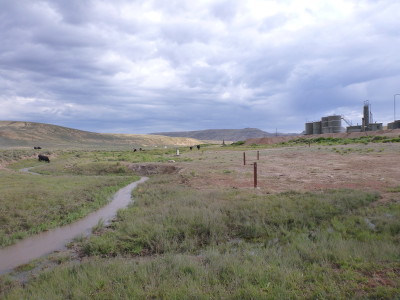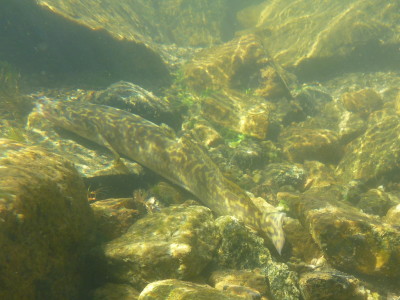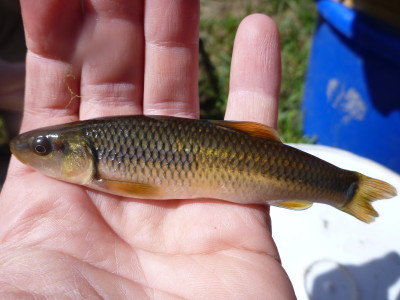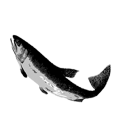Research

We are an applied aquatic ecology lab that conducts research in streams and rivers across Wyoming. Freshwater fishes are a threatened group in North America so many of our research projects are motivated by conservation concerns and have potential implications for management and restoration efforts. We use a variety of techniques and approaches including observational studies, field and laboratory experiments, and modeling. Our research addresses basic questions in population and community ecology and applied questions in conservation biology and fisheries management. A few major research themes in the lab are multiple stressors, fish movement patterns, and native fish conservation.
Multiple stressors
 Aquatic ecosystems are currently subjected to multiple stressors, including habitat degradation, flow alteration, grazing, pollution, invasive species, and climate change. We are interested in understanding how these stressors, individually and interactively, influence aquatic ecosystems. One stressor we have been especially interested in is flow alteration as stream ecosystems experience frequent natural disturbance from droughts and floods and are undergoing considerable anthropogenic disturbance as a result of dam construction and water withdrawal. We are also starting to conduct research on energy development, a stressor particularly relevant to Wyoming. Energy development can affect fish due to shifts in habitat quality, sedimentation rates, water availability, and water quality.
Aquatic ecosystems are currently subjected to multiple stressors, including habitat degradation, flow alteration, grazing, pollution, invasive species, and climate change. We are interested in understanding how these stressors, individually and interactively, influence aquatic ecosystems. One stressor we have been especially interested in is flow alteration as stream ecosystems experience frequent natural disturbance from droughts and floods and are undergoing considerable anthropogenic disturbance as a result of dam construction and water withdrawal. We are also starting to conduct research on energy development, a stressor particularly relevant to Wyoming. Energy development can affect fish due to shifts in habitat quality, sedimentation rates, water availability, and water quality.
Related Projects:
Impacts of natural gas development on the fisheries communities of the Wyoming Range
Ecological responses to multiple stressors in headwater streams of the Wyoming Range
Burbot in the Wind River Drainage
Related Publications:
Barrile, G.M., A. D. Chalfoun, and A.W. Walters. 2021. Livestock grazing, climatic variation, and breeding phenology jointly shape disease dynamics and survival in a wild amphibian. Biological Conservation 261: 109247. doi.org/10.1016/j.biocon.2021.109247 View PDF
Barrile, G.M., A.D. Chalfoun, A.W. Walters. 2021. Infection status as the basis for habitat choices in a wild amphibian. American Naturalist 197: 128-137. doi.org/10.1086/711927 View PDF
Walker, R.H., C.E. Girard, S.L. Alford, and A.W. Walters. 2020. IAnthropogenic land-use change intensifies the effect of low flow on stream fishes. Journal of Applied Ecology 57: 149-159. doi:10.1111/1365-2664.13517 View PDF
Walker, R.H. and A.W. Walters. 2019. A mechanistic understanding of ecological responses to anthropogenic surface disturbance in headwater streams. Ecosphere 10(10):e02907. 10.1002/ecs2.2907. View PDF
Walters, A.W., C. Peterson*, F. Rahel. 2018. The interaction of exposure and sensitivity determines fish species vulnerability to warming stream temperatures. Biology Letters 14:20180342. org/10.1098/rsbl.2018.0342. View PDF
Walters, A.W. The importance of context dependency for understanding the effects of low flow events on fish. Freshwater Science 35:216-228 doi:10.1086/683831. View PDF
Senecal, A. C., A.W. Walters, and W. A. Hubert. 2015. Historical data reveal fish assemblage shifts in an unregulated prairie river. Ecosphere 6(12):287. http://dx.doi.org/10.1890/ES14-00361.1 View PDF
Entrekin, S., K.O. Maloney, K. Kapo, A.W. Walters, M. Evans-White, K. Klemov. 2015. Stream vulnerability to widespread and emergent stressors: a focus on unconventional oil and gas. PLoS ONE 10(9): e0137416. doi:10.1371/journal.pone.0137416. View PDF
Godwin, B.L., S.E. Albeke, H.L. Bergman, A. Walters, and M. Ben-David. 2015. Density of river otters (Lontra canadensis) in relation to energy development in the Green River Basin, Wyoming. Science of the Total Environment 532:780-790. View PDF
Walters, A.W., K.K. Bartz, and M.M. McClure. 2013. Interactive effects of water diversion and climate change for juvenile Chinook salmon in the Lemhi River. Conservation Biology 27:1179-1189. View PDF
Walters, A.W. and D.M. Post. 2011. How low can you go? Response of aquatic insect communities to low flow disturbance. Ecological Applications 21:163-174. View PDF
Fish movement patterns
Fish movement patterns provide insight into population connectivity, habitat requirements, and fish life-history. In addition, fish can be important vectors affecting the flux of energy and materials across ecosystem boundaries. We use a variety of approaches to examine fish movement including PIT-tagging and radio-telemetry to look at movement over the course of a season, stable isotope techniques to look at movement over the course of a lifetime, and genetic analyses to examine long-term movement patterns.
Related Projects:
Movement dynamics and survival of hatchery-reared Colorado River cutthroat trout post-stocking
Burbot in the Wind River Drainage
Related Publications:
Alford, S.A. and A.W. Walters. 2021. Rapid post-disturbance colonisation contributes to native fish resilience. Ecology of Freshwater Fish doi.org/10.1111/eff.12634 View PDF
LeCheminant A.G., G.M. Barrile, S.E. Albeke, A.W. Walters. 2021. Movement dynamics and survival of stocked Colorado River cutthroat trout Oncohynchus clarkii pleuriticus. Transactions of the American Fisheries Society doi.org/10.1002/tafs.10322 View PDF
Barrile, G.M., A.W. Walters, M. Webster, and A.D. Chalfoun. 2021. Informed breeding dispersal following stochastic changes to patch quality in a pond-breeding amphibian. Journal of Animal Ecology doi.org/10.1111/1365-2656.13503 View PDF
Ciepiela, L.R., and A.W. Walters. 2019. Life-history variation of two inland salmonids revealed through otolith microchemistry analysis. Canadian Journal of Fisheries and Aquatic Sciences. 76(11):1971-1981doi.org/10.1139/cjfas-2018-0087. View PDF
Ciepiela, L.R., and A.W. Walters. 2019. Quantifying ⁸⁷Sr/⁸⁶Sr temporal stability and spatial heterogeneity for use in tracking fish movement. Canadian Journal of Fisheries and Aquatic Sciences 76(6): 928-936. doi.org/10.1139/cjfas-2018-0124 View PDF
Hooley-Underwood, Z., E. Mandeville, P. Gerritty, J. Deromedi, K. Johnson, and A.W. Walters. 2018. Combining genetic, isotopic, and field data to better describe movement and entrainment of burbot (Lota lota). Transactions of the American Fisheries Society 147: 606-620. doi/10.1002/tafs.10062. View PDF
Underwood, Z., E. Mandeville, and A.W. Walters. 2016. Population connectivity and genetic clustering of burbot populations in the Wind River Basin, Wyoming. Hydrobiologia 765:329-342. doi: 10.1007/s10750-015-2422-y. View PDF
West, D., A.W. Walters, S. Gephart, D.M. Post. 2010. Nutrient loading by anadromous alewives: contemporary patterns and predictions for restoration efforts. Canadian Journal of Fisheries and Aquatic Sciences 67: 1211-1220. View PDF
Walters, A.W., R.T. Barnes, and D.M. Post. 2009. Anadromous alewife contribute marine-derived nutrients to coastal stream food webs. Canadian Journal of Fisheries and Aquatic Sciences 66:439-448. View PDF
Native fish conservation
Freshwater taxa are declining at a rapid rate due to invasive species, development, dams, habitat degradation, and climate change. The challenge is to be proactive – recognizing threats and putting monitoring and management actions in place before a species has declined to unsustainable levels. We work closely with local managers to develop research projects for species of concern. Many of the projects are focused on evaluating threats and potential management options for a fish species of concern. In addition to species-based analyses we also conduct landscape-level analyses to identify priority management areas that can protect entire aquatic communities.
Related Projects:
Conservation and recovery of hornyhead chub
Movement dynamics and survival of hatchery-reared Colorado River cutthroat trout post-stocking
Related Publications:
B.J. Nordberg, E.G. Mandeville, A.W. Walters, J.C. Burckhardt, and C.E. Wagner. 2021. Historical data illustrate the complex effects of stocking in Cutthroat Trout populations. North American Journal of Fisheries Management doi.org/10.1002/nafm.10593 View PDF
Booher, E. and A.W. Walters. 2021. Biotic and abiotic determinants of finescale dace distribution at the southern edge of their range. Diversity and Distributions 27: 696-709. doi.org/10.1111/ddi.13227 View PDF
Hickerson, B.T.*, B.M. Maitland, and A.W. Walters.2019. Effects of multiple nonnative predatory fish on an imperiled cyprinid, Hornyhead Chub (Nocomis biguttatus). Transactions of the American Fisheries Society 148: 1132-1145 doi,org/10.1002/tafs.10203 View PDF
Hickerson, B.T.* and A.W. Walters. 2019. Evaluation of potential translocation sites for an imperiled cyprinid, Hornyhead Chub (Nocomis biguttatus). North American Journal of Fisheries Management 39:205-218. doi.org/10.1002/nafm.10261 View PDF
Mandeville, E.G.*, A.W. Walters, B.J. Nordberg, K.Higgins, J.C. Burkhardt, and C.E. Wagner. 2019. Genomic outcomes of trout hybridization vary with stocking history. Molecular Ecology 28: 3738-3755 doi.org/10.1111/mec.15175 View PDF
Stewart, D.R., A.W. Walters, and F. Rahel. 2016. Factors influencing native and nonnative Great Plains fishes in Wyoming. Diversity and Distributions 22:225-238 doi: 10.1111/ddi.12383. View PDF
Walters, A.W., T. Copeland, and D.A. Venditti. 2013. The density dilemma: limitations on juvenile production in threatened salmon populations. Ecology of Freshwater Fish 22:508-519. View PDF
Walters, A.W., D. M. Holzer, J. R. Faulkner, C. D. Warren, P. D. Murphy, and M.M. McClure. 2012. Quantifying cumulative entrainment effects for Chinook salmon in a heavily irrigated watershed. Transactions of the American Fisheries Society 141:1180-1190. View PDF


